ISSN ONLINE(2319-8753)PRINT(2347-6710)
ISSN ONLINE(2319-8753)PRINT(2347-6710)
Shivam Nayak 1, Yogesh M. Keskar2
|
| Related article at Pubmed, Scholar Google |
Visit for more related articles at International Journal of Innovative Research in Science, Engineering and Technology
The growing integration of economies and societies of various countries around the world has been one of the most debated topics during the past years. Globalization has a significant impact on the development pattern of the developing country, the concerns of the inequality and environmental degradation due to globalization is a debatable topic. To improve the economic conditions and development pace of the country various country have used the tool of Foreign Direct Investment (FDI). The liberalization of the foreign direct investment policies in India in early 1990s had played a major role in the growth of FDI flow in India. FDI played a multidimensional role in the overall development of the cities in Indian and shaping its present form. It also has enhances the in migration, housing demand, infrastructure requirements in the urban centres were the Multi National Enterprises (MNE’s) has made there setups. Government of India (GOI) has taken various other reforms from the past two decades on the same lines after 1991. Though there are many factors affecting city growth and city form, in this paper we are focusing on the impact of FDI over the city form with a case of Hyderabad city.
Keywords |
| Globalization, FDI, City form, Hyderabad |
INTRODUCTION |
| Globalization has various meanings depending on the context and the person. Guy Brainbant says "The process of globalization not only includes opening up of world trade, development of advanced means of communication, internationalization of financial markets, growing importance of Multi National Company’s (MNC’s), population migrations and more generally increased mobility of persons, goods, capital, data and ideas”. In context to India, this implies opening up the economy to foreign direct investment by providing facilities to foreign companies to invest in different fields of economic activity in India, removing constraints and obstacles to the entry of MNC’s in India, allowing Indian companies to enter into foreign collaborations through various liberalization, therefore globalization has been identified with the policy reforms of 1991 in India. Characteristics features of globalization: Free trade between countries Migration of skilled work force Liberalization Globalization of Economic Activities Connectivity Integration of national economies with the world economy Foreign direct investment (FDI) or foreign investment refers to the net inflows of investment to acquire a lasting management interest (10% or more) in an enterprise operating in an economy other than that of the investor. Foreign direct investment excludes investment through purchase of shares. Foreign direct investment can be used as one measure of growing economic globalization. There are two types of FDI: Inward foreign direct investment Outward foreign direct investment |
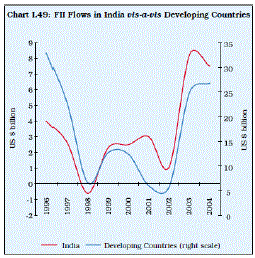 |
| Fig. 1: Impact FII Flows in India vis-à-vis Developing Countries Source: Finance Minister of India Dr Manmohan Singh’s Budget 1992-93 speech to the Parliament |
| During 1990-91 Indian economy was on the verge of collapse. Inflation was accelerating rapidly. The balance of payments was in serious trouble. The foreign exchange reserves were barely enough for two weeks of imports. Foreign commercial banks had stopped lending to India. Non-resident Indians were withdrawing their deposits. Shortages of foreign exchange had forced a massive import squeeze, which had halted the rapid industrial growth of earlier years and had produced negative growth rates from May 1991 onwards. So, reforms in the policies of GOI were required to overcome the phase of crisis. Devaluation: Devaluation of Indian currency by 18-19 percent against major currencies in the international foreign exchange market. Disinvestment: Public sectors undertakings have been sold to private sector to encourage privatization. Dismantling of the industrial Licensing Regime: Liberalized licensing policy (No industrial approval is required from the government for locations not falling within 25kms of the periphery of cities having a population of more than one million). Allowing foreign Direct Investment (FDI): Most activities are opened to foreign investment on automatic route without any limit on the extent of foreign ownership. Non Resident Indian Scheme: Extended concessions especially for NRIs and overseas corporate bodies having more than 60% stake by NRIs in the FDI polices. Throwing open industries reserved for the public sector to private participation. The removal of quantitative restrictions on imports. The reduction of the peak customs tariff: From over 300% prior to the 30% custom tariff. Wide-ranging financial sector reforms: Reforms in banking, capital markets, and insurance sectors . Present situation of FDI in India: Insurance (up to 26%), Development of integrated townships (up to 100%), Defence industry (up to 26%), Tea plantation (upto100%) subject to divestment of 26% within five years to FDI, Enhancement of FDI limits in private sector banking, Allowing FDI up to 100% under the automatic route for most manufacturing activities in SEZs. The union government has sanctioned 51% foreign direct investment in multi-brand like Wal-Mart, Carrefour and Tesco and up to 100% in single brand retail like Gucci, Nokia and Reebok. The new policy will allow multi-brand foreign retailers to set up shop only in cities with a population of more than 10 lakhs as per the 2011 census. There are 53 such cities. This means that big retailers can move beyond the metropolises to smaller cities. FDI is unequally distributed throughout the country, the top six states, viz., Maharashtra, New Delhi, Karnataka, Gujarat, Tamil Nadu and Andhra Pradesh accounted for over 70 per cent of the FDI equity flows to India between 2008-09 and 2011-12. |
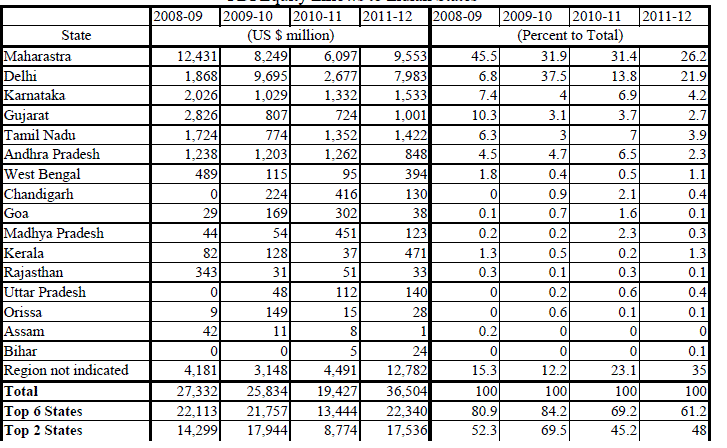 |
| Table: 1 FDI Equity Inflows to Indian States |
| Source: Department of industrial Policy and Promotion (DIPP), Ministry of commerce and Industry, Government of India. |
| Criteria for selection of region by Multi National Enterprises for investment: Infrastructure: Availability of transportation facilities to reach the nearest port or output markets, physical infrastructure in the form of availability of power, telephone density, access to finance, availability of civic amenities and degree of urbanization. Transport infrastructure includes the presence of major ports, close to the coast location, availability and quality of road and rail network, airport (connectivity to domestic and foreign land) Availability of power represented by Electricity generated in that region (state or country) ,water resources availability and supply, availability of other resources. Policy Environment: liberalization of laws and regulations for the admission and establishment of foreign investment projects. In India, as a part of economic reform, many of the states are simplifying the rules and procedures for setting up and operation of the industrial units. Single Window System is now in existence in most of the states. Most of the sector-specific incentives in India take the form of exemption from stamp duty, registration fee, electricity duty and various types of taxes. For e.g. Special Economic Zones (SEZ) also enjoy various incentives mainly in the form of various duty exemptions. Market Size: The size of the local market (generally represented by the scale and growth of a region) acts as one of the most important determinants of location choice of FDI. “There is direct relationship between the market size and FDI inflows” (R. ANITHA : pg.120) As per the Empirical studies conducted in the context of the U S, European Union, China and India have taken into account a number of variables to represent the market size, viz., GDP, growth rate of GDP, per capita income, personal income, population size, population density, population growth, consumption level, number of potential sites in a state, etc. (Atri Mukherjee : pg.110) Industrial Linkages: MNE looks for foreign locations that possess natural resources and related transport and communication infrastructure, tax and other incentives. (Dunning :1993) Natural resources include oil, mineral, raw materials and agricultural products. The states with higher industrial output have attracted high levels of FDI (Siddharthan :2006). Selection of region is also influenced to a large extent by the availability of non-material knowledge-intensive assets mainly driven by the tremendous growth of the services sector, particularly knowledge and information oriented services (Dunning: 1998) Labor Conditions: Foreign firms are expected to prefer lower wage locations to minimize their cost of production. Quality of labor is also an important influential factor for selection i.e. skilled or unskilled labor, educated or uneducated. Quality of labor can be assessed by literacy rate and per capita number of educational institutions for higher studies (degree and above) in each state |
| Agglomeration Economies: MNE has the tendency to attract to the regions were other criteria are matched properly; subsequently they gravitate closer to the related industries. In the process, industry clusters are formed, with each geographical area specializing in certain activities, leading to spatial diffusion of industries. Regions are preferred having peripheral or adjacent area were the localized support facilities and services, distribution network, consumer market can be shared. |
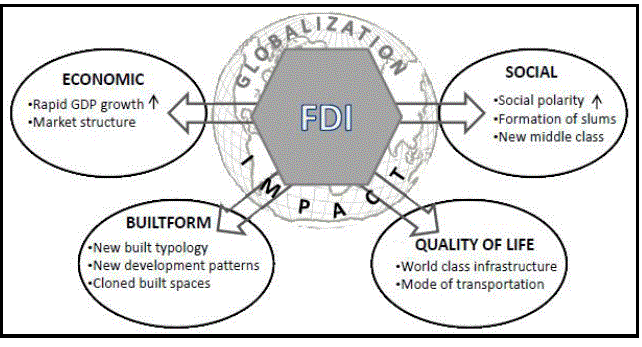 |
| Fig. 2: Impact of FDI over host region. |
| FDI has a major impact over the host country/city/region due to its direct involvement with the host`s economy and also generates new growth centres within or around the city. It also connects the host region to the outside world and enhances the globalization of the region or area. The impacts are categorized into four parts: (1)Economic (2) Social impacts (3) Impact over the built form (4) Impact over the quality of life 1. Economic Impacts: Rapid economic growth in the investment region, the skilled labor force in an economy will benefit from the higher wages from the Trans National Company (TNC) were as unskilled workers may be forced out of the labor market. So the gap between poor and rich is becoming bigger. New slums are developed in the city near to the TNC’s. Due to the varied potentials of the region / area to attract FDI causes uneven distribution of FDI flow and results into regional Economic inequalities. Competitive environment is developed by the TNC’s in the local market with their cheap, latest, standardized products which are developed with precision and with latest technologies. These TNC’s have large supply chain of raw materials and funds from various parts of the world. To sustain in the market the local suppliers/ manufacturers or the retailers has to compete with the TNC’s strategies and products. The FDI has majorly influenced the organized retailing in India as compared to unorganized retailing. Big retail stores and group have converted into big showrooms and retail chains similar to western concept of retailing. 2. Social Impacts: Due to the MNE`s investments in the region causes the formation of a new middle class / high-level professional workforce that occupies white-collar jobs and characterized by a shared education, lifestyle, consumption patterns and occupations. Social polarization in the society is becoming stronger as changes in the absolute and relative size of different income groups over time. (Directly inferred through the structure of the high-income lifestyles of those employed in the service sector (e.g. high income residential and commercial gentrification) 3. Impact Over The Built Form: Emergence of new retail and wholesale: new building typology is being introduced in the cities with large building footprints and building interface (Malls, hyper markets) To compete with upcoming foreign brands and retail chains the native big retailers have also stepped into the branding and started retail chains e.g. more, Vishal Mega-Mart, Reliance group and decreasing unorganized retail stores influence (kirana shops, hawkers). Huge ware house type block are introduced in the cities to house Multi-brand retail and wholesale stores E.g. Wal-Mart, Cosco Isolated knowledge campus with various relaxation policies are publicized and supported like SEZ Development pattern majorly focused around the area with MNE investments like I.T. hub, or Industrial Hub with emergence of new housing typology (service apartments) and isolated neighborhoods (fragmented development pattern) Emergence of cloned built spaces: |
| To attract the new middle class of the city and the Foreign visitors cloned spaces are evolved in the city. Example McDonald, Dominos, US Pizzas, levis store, electronic stores, vehicle showrooms (Audi, BMW) 4. Impact over the Quality Of Life: Change in the preferred mode Of Transportation. There is major Shift towards private mode from public mode I.e. More dependency on the private car and two wheelers. Public transport develops in the focused area with MNE investment. Example BRTS, Metro, MMTS, etc. Infrastructure and streetscape are developed to match the world class standards to attract a safe and standardized environment. To provide safe and secure environment to the MNE the Security of the areas are improved and is on first preference of the governing authority. |
II. AREA OF STUDY: HYDERABAD CITY, ANDHRA PRADESH, INDIA |
| Hyderabad is the capital and largest city of the Indian state of Andhra Pradesh. It occupies 650 square kilometers. The city is located on the banks of the Musi River on the Deccan Plateau. The population of the city is 6.8 million and that of its metropolitan area is 7.75 million (Source: Census 2011) making it India's fourth most populous city and sixth most populous urban agglomeration. Hyderabad was well known for diamond trading centre, and it continues to be known as the City of Pearls. Many of the city's traditional bazaars, including Laad Bazaar,Begum Bazaar and Sultan Bazaar, have remained open for centuries. However, industrialization throughout the 20th century has also attracted major Indian manufacturing, research and financial institutions, further developed as a hub of various industries (IT, Biotechnology, manufacturing, etc.). Due to immense growth of city and huge expansions of city limits, there are emergence of new governance institutions for developed new growth centers i.e. Hyderabad Municipal Corporation was expanded in 2007 to form the Greater Hyderabad Municipal Corporation. HMDA was formed by the merging of the following erstwhile entities: Hyderabad Urban Development Authority (HUDA), Hyderabad Airport Development Authority (HADA), Cyberabad Development Authority (CDA) and Buddha Poornima Project Authority (BPPA). Hyderabad has various reasons to become an ideal city to Multi-national enterprises for investment like Centrally located: Hyderabad is well connected by Air, Rail and Road and is just 2 hours flying distance from any major metro in the country. City Quality of life: All the advantages of a metropolitan center, without the congestion and all the mega-city comforts at small-town costs. Low operation costs: Low real-estate prices as compared to any other big city or metro in India. Rich manpower: Hyderabad is rich in literate and well trained IT manpower. Hyderabad is governed by the most explicitly industry-friendly administration in India today. Due to various reforms taken up by the government of Andhra Pradesh in Hyderabad has attracted IT and pharmaceutical industries to setup their work centers and in a short period of time Hyderabad has evolved as a important IT centre on national and international level. Some of the reforms are: o GoAP has provided the right regulatory framework as well as state of the art infrastructure at selected locations (cyber tower, cyber gateway, and international convention centre (HITEX)), o Large areas of land are allotted to IT companies like Microsoft and Infosys to build their campus. (Microsoft’s Cyberabad campus, with more than 12 000 employees, is the largest dependency of the firm outside the US), o Lands are also allotted to private developers to develop IT parks (Raheja Mind Space (110 acres of land allotted by APIIC)), o World class education institutes (ISB (2001), IIIT (1998)) were established, for research and support to the upcoming IT industry. Change in Development Growth Pattern of the city Development pattern has shifted from mono-centric to poly-centric pattern with development of new economic growth centres in the city. |
| The old area has suffered a decline and peripheral areas have begun to play a more dominant role in growth and employment generation. This is reflected in their significantly higher demographic expansion rate. |
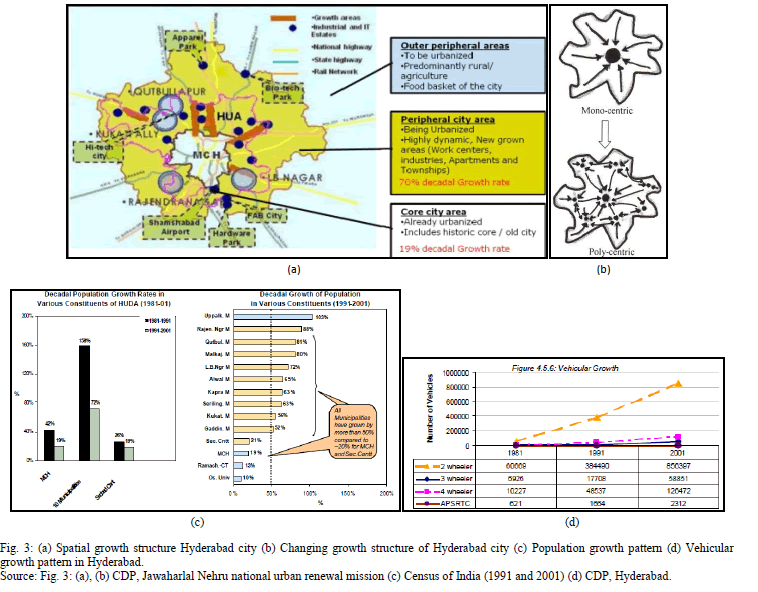 |
| Private and Para-transit modes have grown substantially. The growth of buses has not kept pace with the growth rate of population. There is an attitudinal shift of people to use private vehicle rather than public transport, due change in lifestyle, up gradation in financial condition of people. The modal share of private vehicle (cars, jeeps & two wheelers) is about 50%. Major transportation issue faced is the numerous commuters due to substantial external-to-external flows across the core area are also being sponsored due explosive growth of the surrounding municipalities and certain activity centres. In absence of convenient by pass roads, these flows are being funnelled through existing travel corridors of MCH area. To overcome these congestion issues government has undertaken various projects to Strengthen and development of new and old movement corridors. Major roads and radial link corridors are strengthened via road widening and flyovers at major junction with congestion. Outer ring Road is developed to reduce the commuting traffic passing from the core areas and linking all the hubs (IT SEZ, manufacturing SEZ, Biotechnology, gems and jewellery SEZ) with one express corridor. Improve connectivity and decongest the traffic flow on the existing major arterials between the outer suburbs of Greater Hyderabad. |
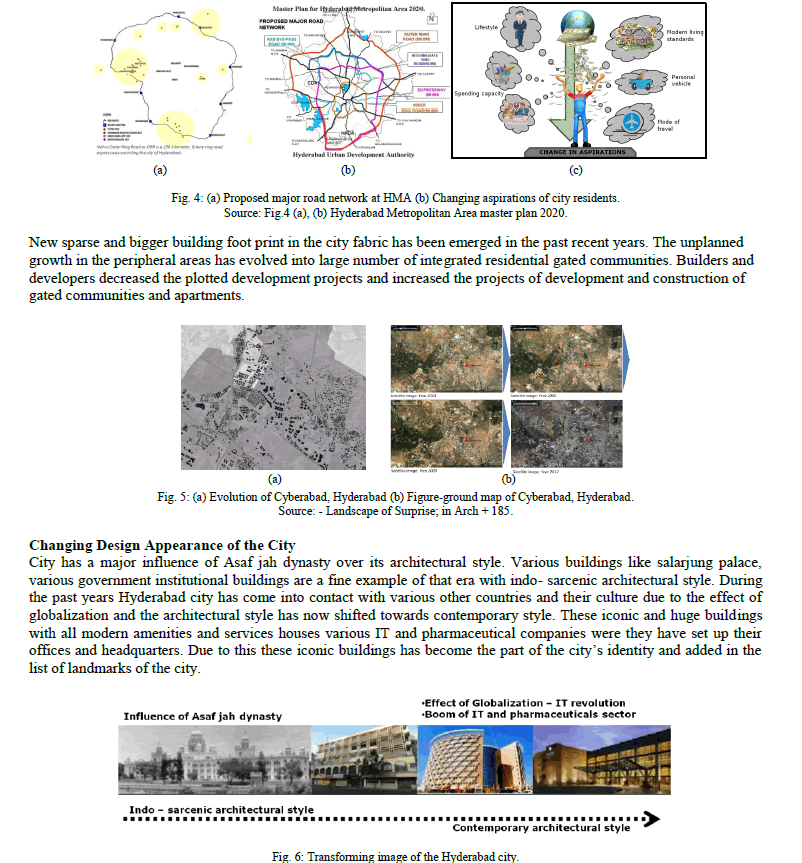 |
 |
| Change in skyline of the city due to the emergence of new elements in the skyline of the city like new scale of built structure (high-rise residential towers), massive contemporary glass covered structures (IT offices), telecommunication towers, huge bill boards. Internationalization of spaces caused due to the migration of various NRIs, foreign people and growth of new upper middle class in the city. IT hub has a major impact over the branding of the Spaces. New development focused on the NRI, foreign migrants, elite class and the newly evolved upper middle class of the society. Projects have high quality standards, Projects have replica of foreign land spaces (landscaping pattern, form, colour scheme, etc.), and Projects have all integrated world class facilities and amenities (Club, sports, shopping arcade, workplace) |
III. CONCLUSION |
| Investment from global economy is a way to expand or develop the host economy by adding new assets and financial input from external economy. These foreign investments bring with them various reforms in Construction, Market structure, Telecommunication, Urban aspirations in the city/region. Development and growth of the city are predominantly found near the MNE investment region with rapid growth of population more through in-migration as compared to natural growth, raised human aspirations with improved financial conditions, booming land prices forced the development in the vertical direction which has impacted the city form. These aspects of in-migration, housing requirement, public transport and supporting infrastructure has to be taken into consideration while planning and designing for the development of the peripheral areas of the city. This will give the authorities the projected figures and the image of the upcoming built areas and developed areas to give check on regulatory measures for development. These Projected figures and image of upcoming built areas and developed areas will help the authorities to give a check on regulatory measures for development. |
ACKNOWLEDGMENT |
| We are very much thankful to Prof. Piyush Hajela and Ar. Nupoor Saran Saboo in School of Planning and Architecture Bhopal, for their valuable guidance for this paper. |